Familiarity and Inattentional Blindness
VerifiedAdded on 2022/12/27
|11
|2787
|62
AI Summary
This research study examines the relationship between familiarity and inattentional blindness. It explores how familiarity affects the ability to detect changes in objects and colors. The study finds that familiarity has a direct and reciprocal relationship with inattentional blindness, with familiar observers being more likely to detect new objects in the observational frame and unfamiliar observers being more likely to detect changes in color and the elimination of objects.
Contribute Materials
Your contribution can guide someone’s learning journey. Share your
documents today.
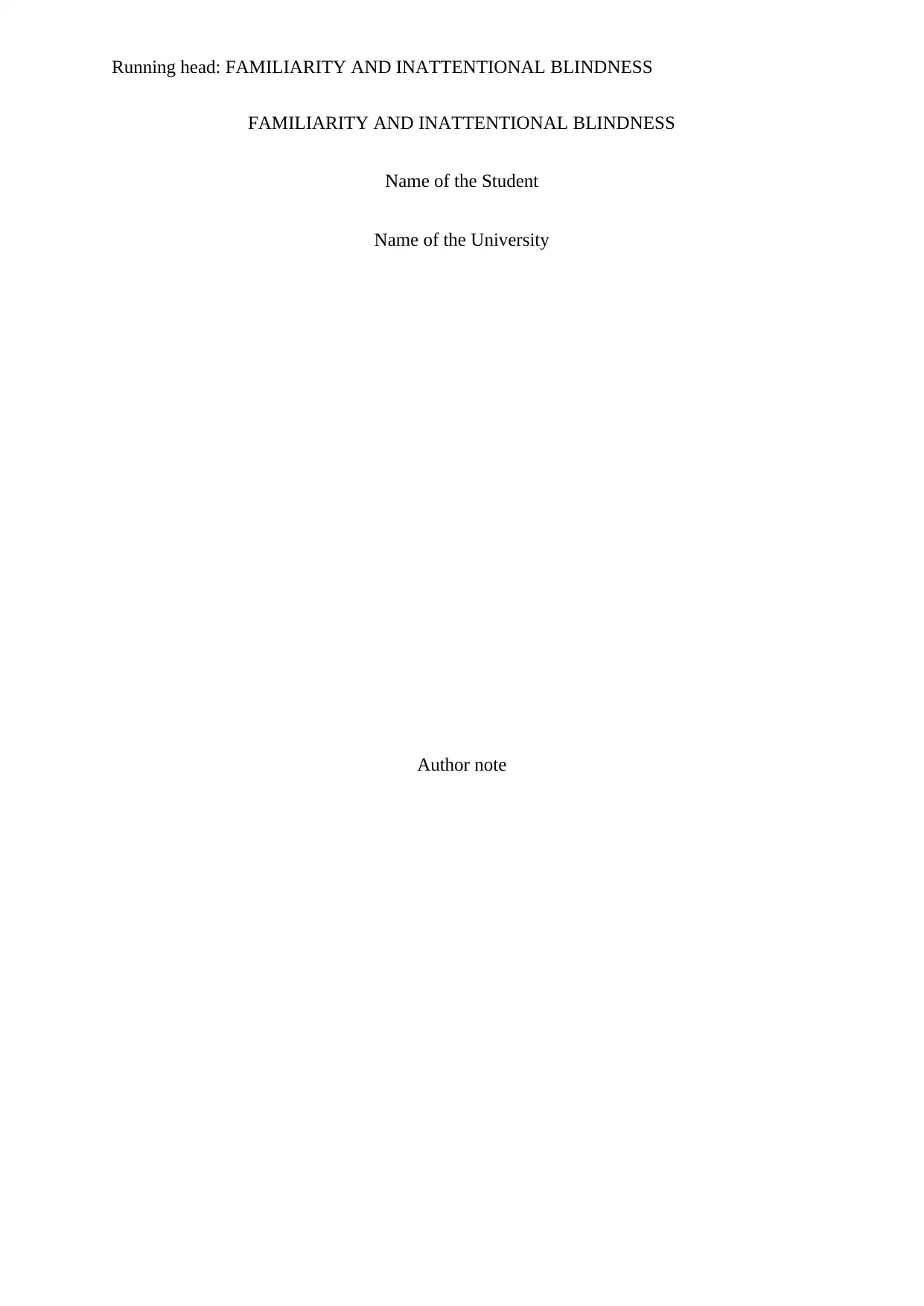
Running head: FAMILIARITY AND INATTENTIONAL BLINDNESS
FAMILIARITY AND INATTENTIONAL BLINDNESS
Name of the Student
Name of the University
Author note
FAMILIARITY AND INATTENTIONAL BLINDNESS
Name of the Student
Name of the University
Author note
Secure Best Marks with AI Grader
Need help grading? Try our AI Grader for instant feedback on your assignments.
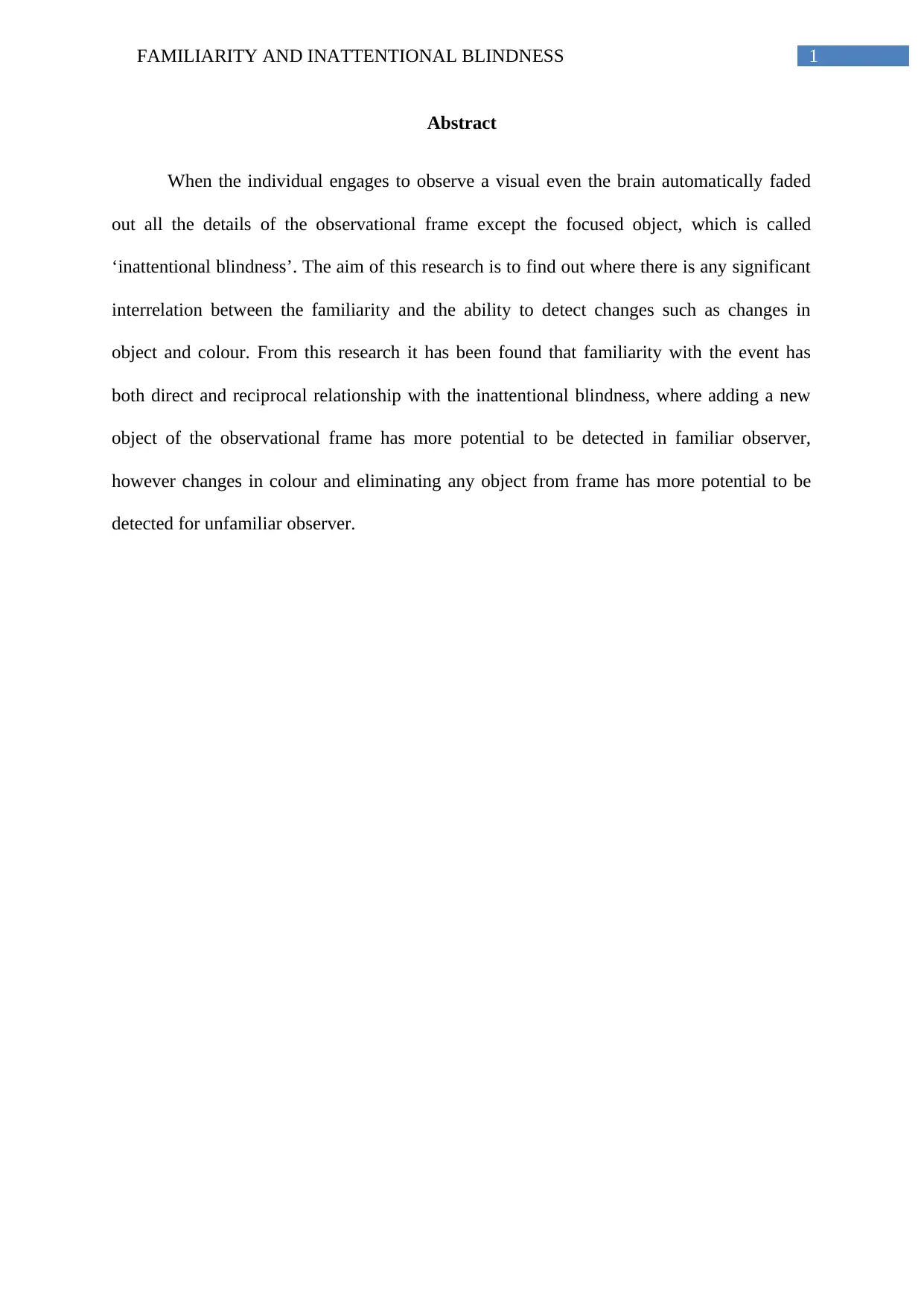
1FAMILIARITY AND INATTENTIONAL BLINDNESS
Abstract
When the individual engages to observe a visual even the brain automatically faded
out all the details of the observational frame except the focused object, which is called
‘inattentional blindness’. The aim of this research is to find out where there is any significant
interrelation between the familiarity and the ability to detect changes such as changes in
object and colour. From this research it has been found that familiarity with the event has
both direct and reciprocal relationship with the inattentional blindness, where adding a new
object of the observational frame has more potential to be detected in familiar observer,
however changes in colour and eliminating any object from frame has more potential to be
detected for unfamiliar observer.
Abstract
When the individual engages to observe a visual even the brain automatically faded
out all the details of the observational frame except the focused object, which is called
‘inattentional blindness’. The aim of this research is to find out where there is any significant
interrelation between the familiarity and the ability to detect changes such as changes in
object and colour. From this research it has been found that familiarity with the event has
both direct and reciprocal relationship with the inattentional blindness, where adding a new
object of the observational frame has more potential to be detected in familiar observer,
however changes in colour and eliminating any object from frame has more potential to be
detected for unfamiliar observer.
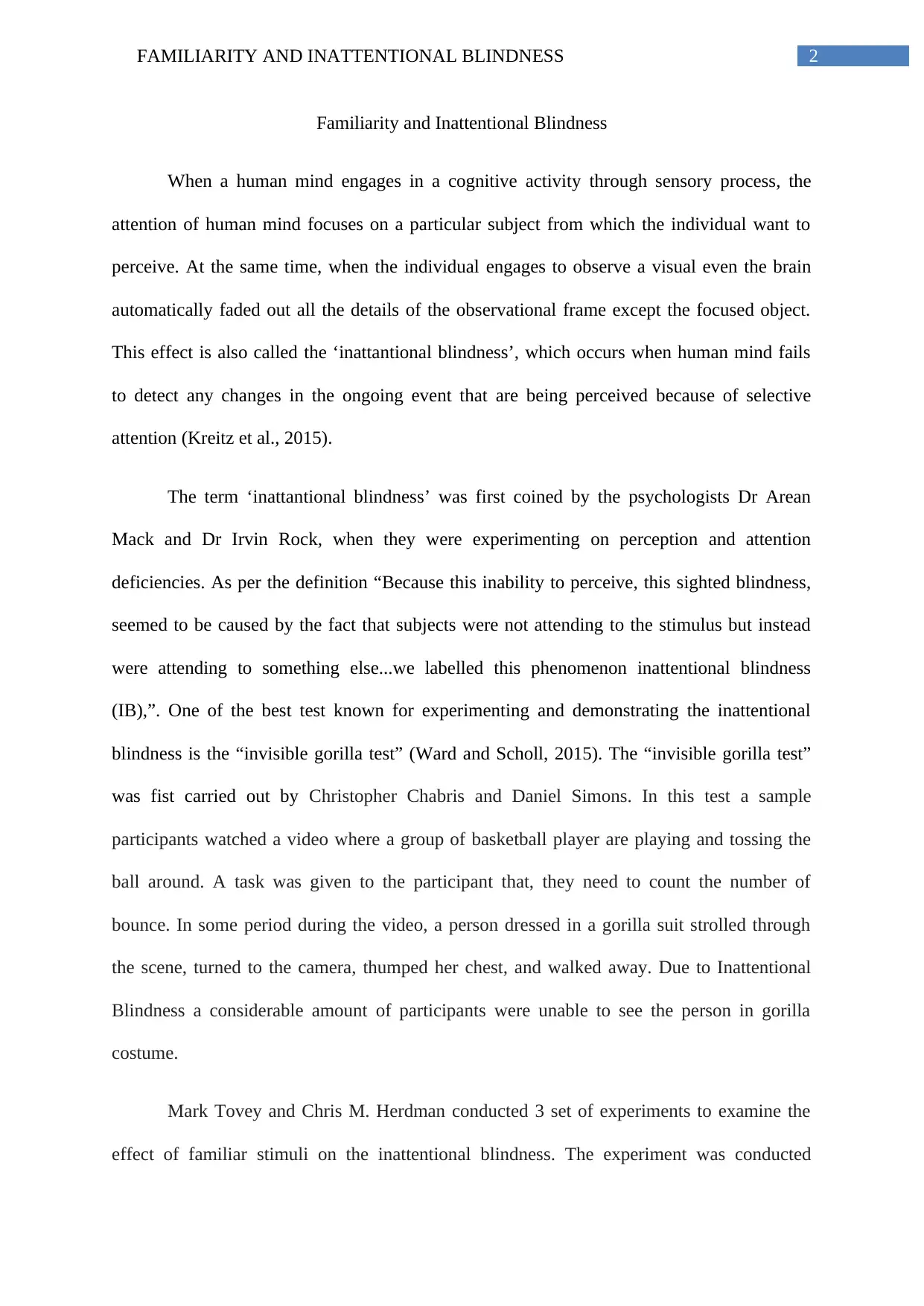
2FAMILIARITY AND INATTENTIONAL BLINDNESS
Familiarity and Inattentional Blindness
When a human mind engages in a cognitive activity through sensory process, the
attention of human mind focuses on a particular subject from which the individual want to
perceive. At the same time, when the individual engages to observe a visual even the brain
automatically faded out all the details of the observational frame except the focused object.
This effect is also called the ‘inattantional blindness’, which occurs when human mind fails
to detect any changes in the ongoing event that are being perceived because of selective
attention (Kreitz et al., 2015).
The term ‘inattantional blindness’ was first coined by the psychologists Dr Arean
Mack and Dr Irvin Rock, when they were experimenting on perception and attention
deficiencies. As per the definition “Because this inability to perceive, this sighted blindness,
seemed to be caused by the fact that subjects were not attending to the stimulus but instead
were attending to something else...we labelled this phenomenon inattentional blindness
(IB),”. One of the best test known for experimenting and demonstrating the inattentional
blindness is the “invisible gorilla test” (Ward and Scholl, 2015). The “invisible gorilla test”
was fist carried out by Christopher Chabris and Daniel Simons. In this test a sample
participants watched a video where a group of basketball player are playing and tossing the
ball around. A task was given to the participant that, they need to count the number of
bounce. In some period during the video, a person dressed in a gorilla suit strolled through
the scene, turned to the camera, thumped her chest, and walked away. Due to Inattentional
Blindness a considerable amount of participants were unable to see the person in gorilla
costume.
Mark Tovey and Chris M. Herdman conducted 3 set of experiments to examine the
effect of familiar stimuli on the inattentional blindness. The experiment was conducted
Familiarity and Inattentional Blindness
When a human mind engages in a cognitive activity through sensory process, the
attention of human mind focuses on a particular subject from which the individual want to
perceive. At the same time, when the individual engages to observe a visual even the brain
automatically faded out all the details of the observational frame except the focused object.
This effect is also called the ‘inattantional blindness’, which occurs when human mind fails
to detect any changes in the ongoing event that are being perceived because of selective
attention (Kreitz et al., 2015).
The term ‘inattantional blindness’ was first coined by the psychologists Dr Arean
Mack and Dr Irvin Rock, when they were experimenting on perception and attention
deficiencies. As per the definition “Because this inability to perceive, this sighted blindness,
seemed to be caused by the fact that subjects were not attending to the stimulus but instead
were attending to something else...we labelled this phenomenon inattentional blindness
(IB),”. One of the best test known for experimenting and demonstrating the inattentional
blindness is the “invisible gorilla test” (Ward and Scholl, 2015). The “invisible gorilla test”
was fist carried out by Christopher Chabris and Daniel Simons. In this test a sample
participants watched a video where a group of basketball player are playing and tossing the
ball around. A task was given to the participant that, they need to count the number of
bounce. In some period during the video, a person dressed in a gorilla suit strolled through
the scene, turned to the camera, thumped her chest, and walked away. Due to Inattentional
Blindness a considerable amount of participants were unable to see the person in gorilla
costume.
Mark Tovey and Chris M. Herdman conducted 3 set of experiments to examine the
effect of familiar stimuli on the inattentional blindness. The experiment was conducted
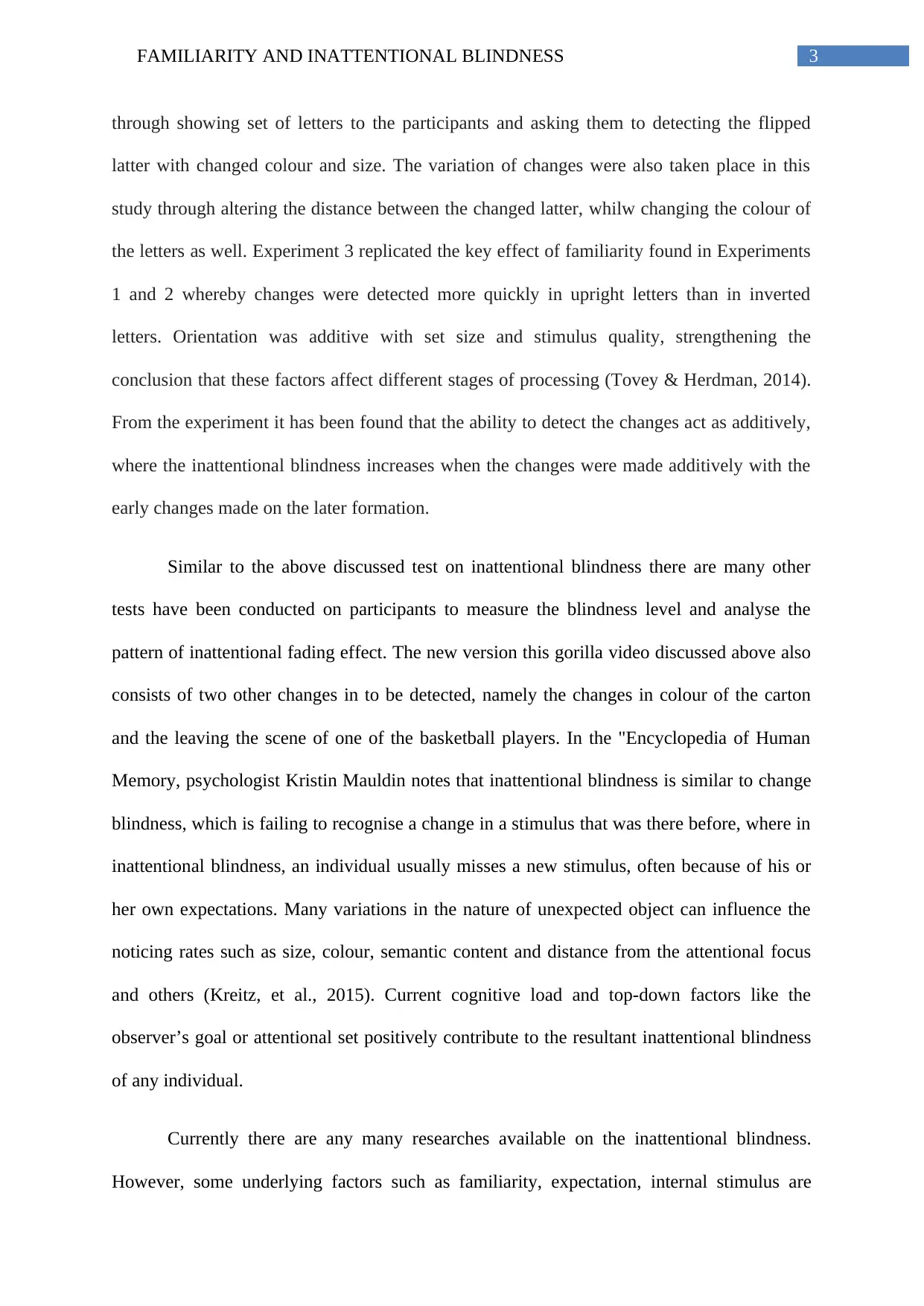
3FAMILIARITY AND INATTENTIONAL BLINDNESS
through showing set of letters to the participants and asking them to detecting the flipped
latter with changed colour and size. The variation of changes were also taken place in this
study through altering the distance between the changed latter, whilw changing the colour of
the letters as well. Experiment 3 replicated the key effect of familiarity found in Experiments
1 and 2 whereby changes were detected more quickly in upright letters than in inverted
letters. Orientation was additive with set size and stimulus quality, strengthening the
conclusion that these factors affect different stages of processing (Tovey & Herdman, 2014).
From the experiment it has been found that the ability to detect the changes act as additively,
where the inattentional blindness increases when the changes were made additively with the
early changes made on the later formation.
Similar to the above discussed test on inattentional blindness there are many other
tests have been conducted on participants to measure the blindness level and analyse the
pattern of inattentional fading effect. The new version this gorilla video discussed above also
consists of two other changes in to be detected, namely the changes in colour of the carton
and the leaving the scene of one of the basketball players. In the "Encyclopedia of Human
Memory, psychologist Kristin Mauldin notes that inattentional blindness is similar to change
blindness, which is failing to recognise a change in a stimulus that was there before, where in
inattentional blindness, an individual usually misses a new stimulus, often because of his or
her own expectations. Many variations in the nature of unexpected object can influence the
noticing rates such as size, colour, semantic content and distance from the attentional focus
and others (Kreitz, et al., 2015). Current cognitive load and top-down factors like the
observer’s goal or attentional set positively contribute to the resultant inattentional blindness
of any individual.
Currently there are any many researches available on the inattentional blindness.
However, some underlying factors such as familiarity, expectation, internal stimulus are
through showing set of letters to the participants and asking them to detecting the flipped
latter with changed colour and size. The variation of changes were also taken place in this
study through altering the distance between the changed latter, whilw changing the colour of
the letters as well. Experiment 3 replicated the key effect of familiarity found in Experiments
1 and 2 whereby changes were detected more quickly in upright letters than in inverted
letters. Orientation was additive with set size and stimulus quality, strengthening the
conclusion that these factors affect different stages of processing (Tovey & Herdman, 2014).
From the experiment it has been found that the ability to detect the changes act as additively,
where the inattentional blindness increases when the changes were made additively with the
early changes made on the later formation.
Similar to the above discussed test on inattentional blindness there are many other
tests have been conducted on participants to measure the blindness level and analyse the
pattern of inattentional fading effect. The new version this gorilla video discussed above also
consists of two other changes in to be detected, namely the changes in colour of the carton
and the leaving the scene of one of the basketball players. In the "Encyclopedia of Human
Memory, psychologist Kristin Mauldin notes that inattentional blindness is similar to change
blindness, which is failing to recognise a change in a stimulus that was there before, where in
inattentional blindness, an individual usually misses a new stimulus, often because of his or
her own expectations. Many variations in the nature of unexpected object can influence the
noticing rates such as size, colour, semantic content and distance from the attentional focus
and others (Kreitz, et al., 2015). Current cognitive load and top-down factors like the
observer’s goal or attentional set positively contribute to the resultant inattentional blindness
of any individual.
Currently there are any many researches available on the inattentional blindness.
However, some underlying factors such as familiarity, expectation, internal stimulus are
Secure Best Marks with AI Grader
Need help grading? Try our AI Grader for instant feedback on your assignments.
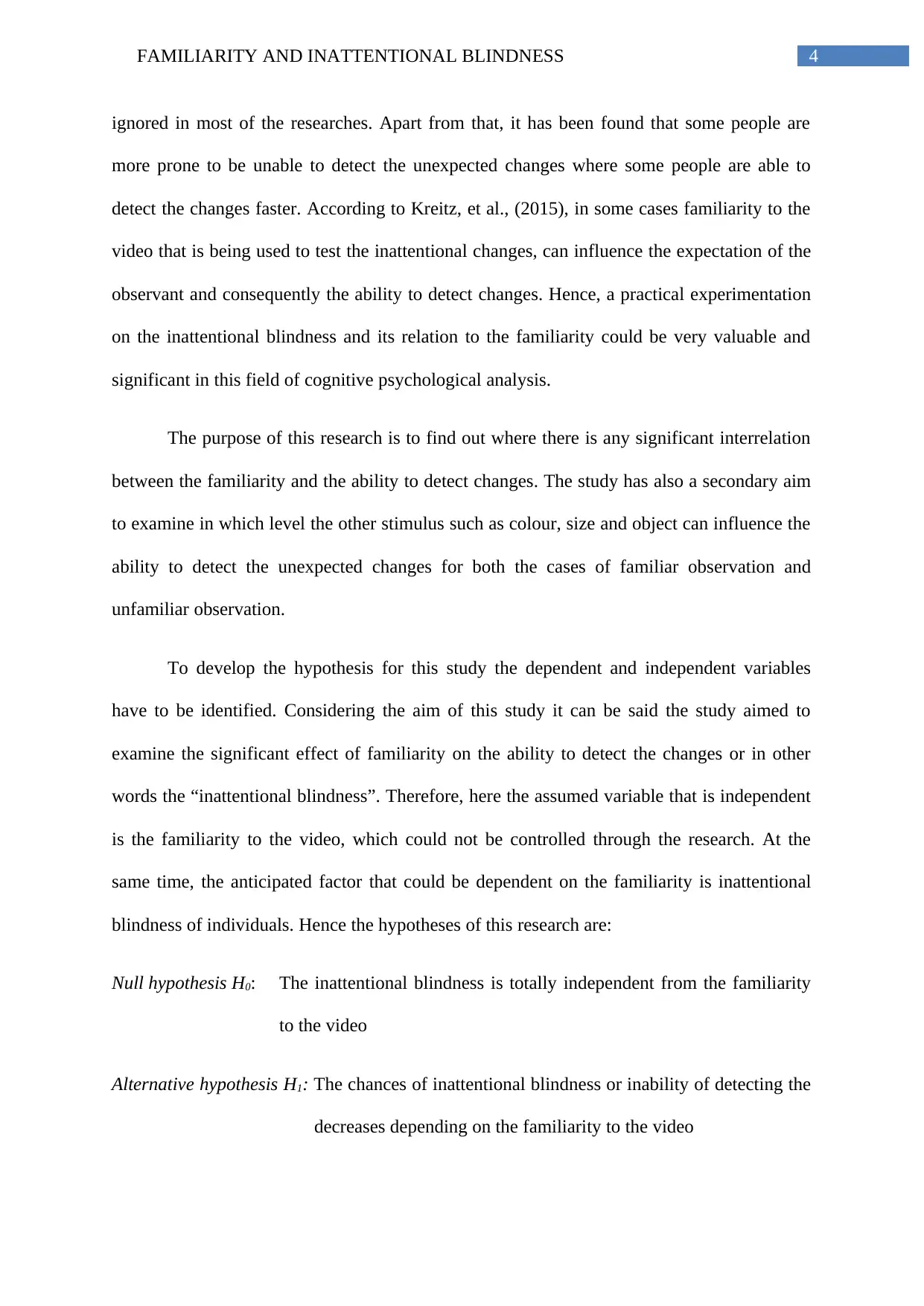
4FAMILIARITY AND INATTENTIONAL BLINDNESS
ignored in most of the researches. Apart from that, it has been found that some people are
more prone to be unable to detect the unexpected changes where some people are able to
detect the changes faster. According to Kreitz, et al., (2015), in some cases familiarity to the
video that is being used to test the inattentional changes, can influence the expectation of the
observant and consequently the ability to detect changes. Hence, a practical experimentation
on the inattentional blindness and its relation to the familiarity could be very valuable and
significant in this field of cognitive psychological analysis.
The purpose of this research is to find out where there is any significant interrelation
between the familiarity and the ability to detect changes. The study has also a secondary aim
to examine in which level the other stimulus such as colour, size and object can influence the
ability to detect the unexpected changes for both the cases of familiar observation and
unfamiliar observation.
To develop the hypothesis for this study the dependent and independent variables
have to be identified. Considering the aim of this study it can be said the study aimed to
examine the significant effect of familiarity on the ability to detect the changes or in other
words the “inattentional blindness”. Therefore, here the assumed variable that is independent
is the familiarity to the video, which could not be controlled through the research. At the
same time, the anticipated factor that could be dependent on the familiarity is inattentional
blindness of individuals. Hence the hypotheses of this research are:
Null hypothesis H0: The inattentional blindness is totally independent from the familiarity
to the video
Alternative hypothesis H1: The chances of inattentional blindness or inability of detecting the
decreases depending on the familiarity to the video
ignored in most of the researches. Apart from that, it has been found that some people are
more prone to be unable to detect the unexpected changes where some people are able to
detect the changes faster. According to Kreitz, et al., (2015), in some cases familiarity to the
video that is being used to test the inattentional changes, can influence the expectation of the
observant and consequently the ability to detect changes. Hence, a practical experimentation
on the inattentional blindness and its relation to the familiarity could be very valuable and
significant in this field of cognitive psychological analysis.
The purpose of this research is to find out where there is any significant interrelation
between the familiarity and the ability to detect changes. The study has also a secondary aim
to examine in which level the other stimulus such as colour, size and object can influence the
ability to detect the unexpected changes for both the cases of familiar observation and
unfamiliar observation.
To develop the hypothesis for this study the dependent and independent variables
have to be identified. Considering the aim of this study it can be said the study aimed to
examine the significant effect of familiarity on the ability to detect the changes or in other
words the “inattentional blindness”. Therefore, here the assumed variable that is independent
is the familiarity to the video, which could not be controlled through the research. At the
same time, the anticipated factor that could be dependent on the familiarity is inattentional
blindness of individuals. Hence the hypotheses of this research are:
Null hypothesis H0: The inattentional blindness is totally independent from the familiarity
to the video
Alternative hypothesis H1: The chances of inattentional blindness or inability of detecting the
decreases depending on the familiarity to the video
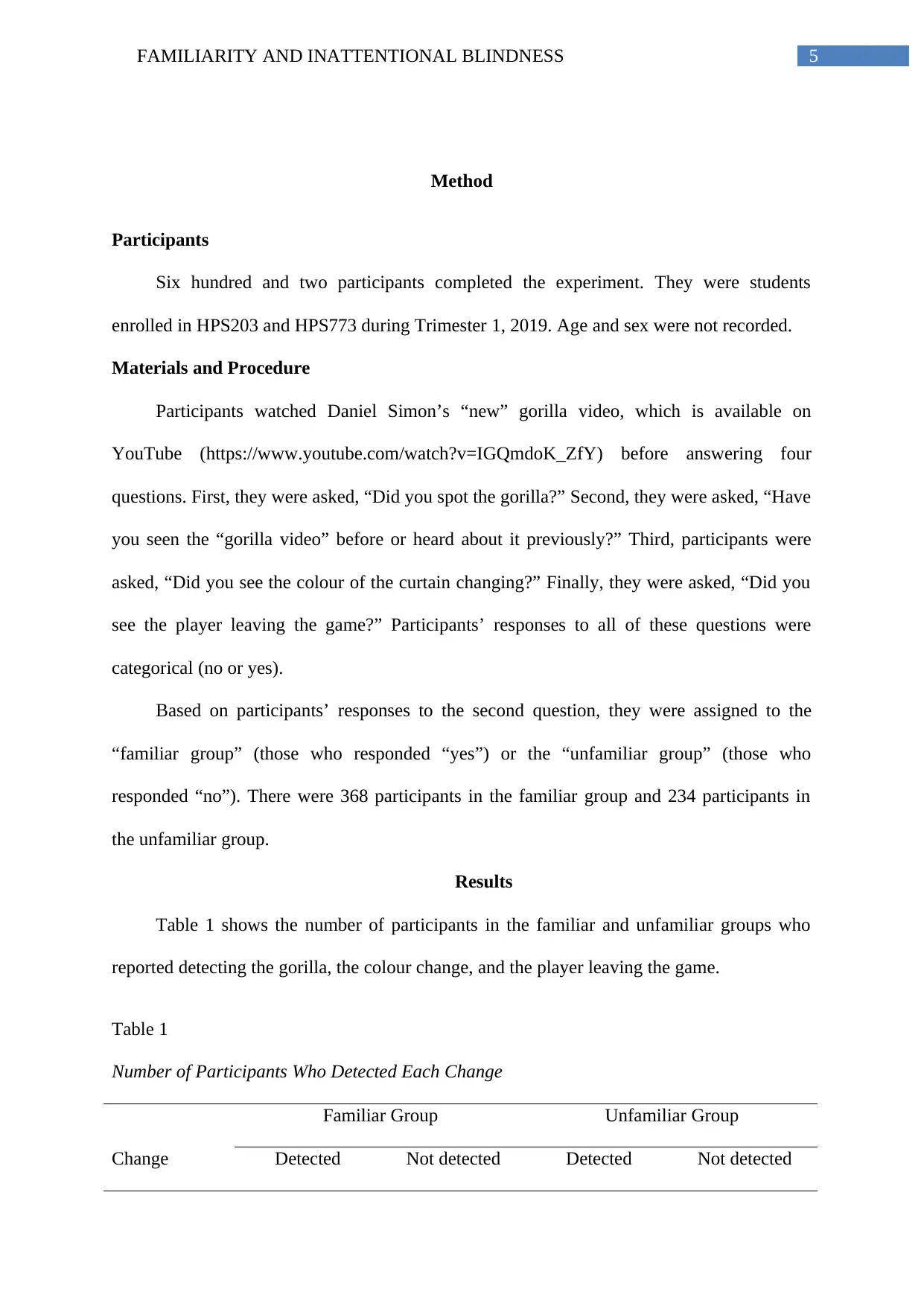
5FAMILIARITY AND INATTENTIONAL BLINDNESS
Method
Participants
Six hundred and two participants completed the experiment. They were students
enrolled in HPS203 and HPS773 during Trimester 1, 2019. Age and sex were not recorded.
Materials and Procedure
Participants watched Daniel Simon’s “new” gorilla video, which is available on
YouTube (https://www.youtube.com/watch?v=IGQmdoK_ZfY) before answering four
questions. First, they were asked, “Did you spot the gorilla?” Second, they were asked, “Have
you seen the “gorilla video” before or heard about it previously?” Third, participants were
asked, “Did you see the colour of the curtain changing?” Finally, they were asked, “Did you
see the player leaving the game?” Participants’ responses to all of these questions were
categorical (no or yes).
Based on participants’ responses to the second question, they were assigned to the
“familiar group” (those who responded “yes”) or the “unfamiliar group” (those who
responded “no”). There were 368 participants in the familiar group and 234 participants in
the unfamiliar group.
Results
Table 1 shows the number of participants in the familiar and unfamiliar groups who
reported detecting the gorilla, the colour change, and the player leaving the game.
Table 1
Number of Participants Who Detected Each Change
Familiar Group Unfamiliar Group
Change Detected Not detected Detected Not detected
Method
Participants
Six hundred and two participants completed the experiment. They were students
enrolled in HPS203 and HPS773 during Trimester 1, 2019. Age and sex were not recorded.
Materials and Procedure
Participants watched Daniel Simon’s “new” gorilla video, which is available on
YouTube (https://www.youtube.com/watch?v=IGQmdoK_ZfY) before answering four
questions. First, they were asked, “Did you spot the gorilla?” Second, they were asked, “Have
you seen the “gorilla video” before or heard about it previously?” Third, participants were
asked, “Did you see the colour of the curtain changing?” Finally, they were asked, “Did you
see the player leaving the game?” Participants’ responses to all of these questions were
categorical (no or yes).
Based on participants’ responses to the second question, they were assigned to the
“familiar group” (those who responded “yes”) or the “unfamiliar group” (those who
responded “no”). There were 368 participants in the familiar group and 234 participants in
the unfamiliar group.
Results
Table 1 shows the number of participants in the familiar and unfamiliar groups who
reported detecting the gorilla, the colour change, and the player leaving the game.
Table 1
Number of Participants Who Detected Each Change
Familiar Group Unfamiliar Group
Change Detected Not detected Detected Not detected
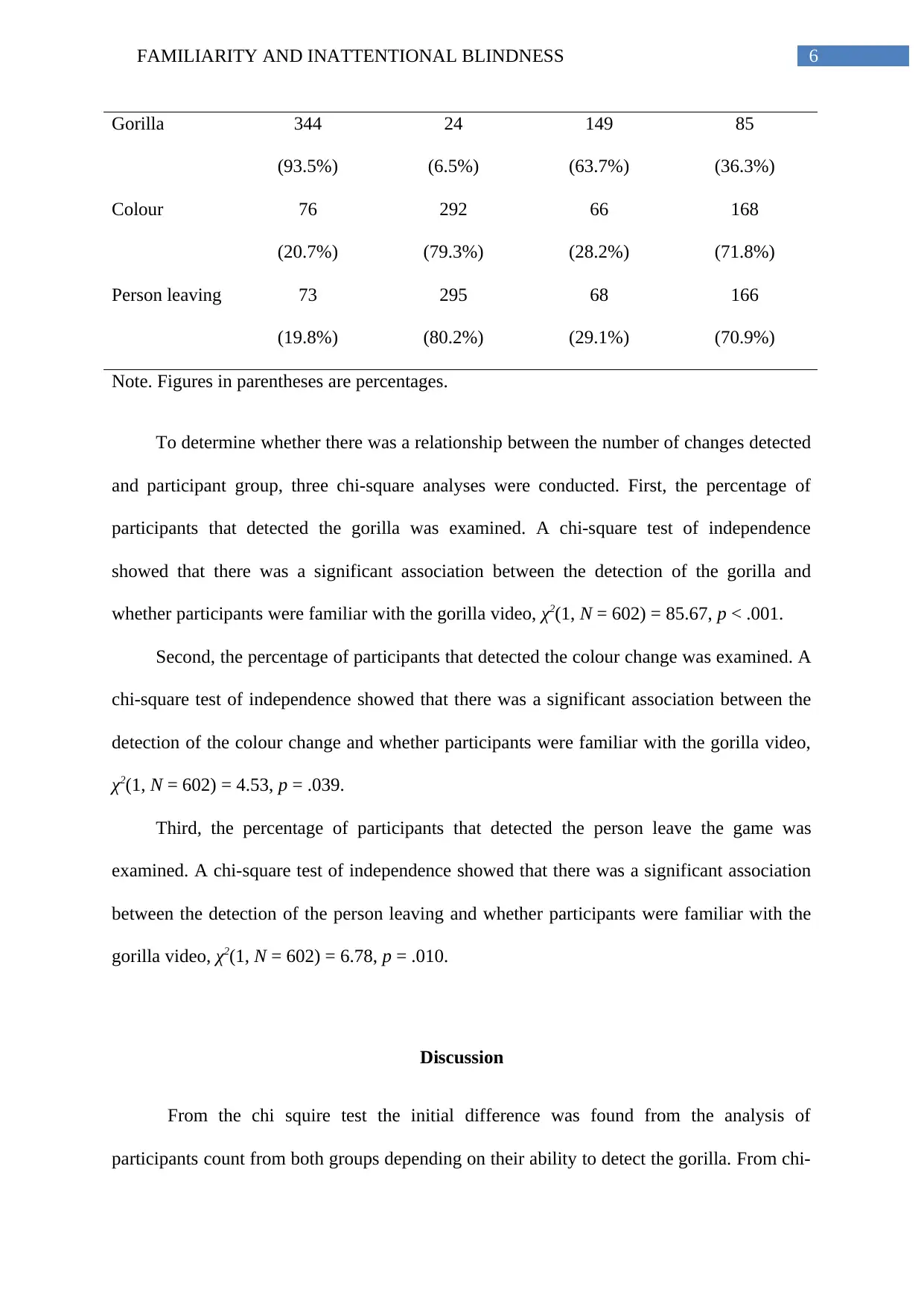
6FAMILIARITY AND INATTENTIONAL BLINDNESS
Gorilla 344
(93.5%)
24
(6.5%)
149
(63.7%)
85
(36.3%)
Colour 76
(20.7%)
292
(79.3%)
66
(28.2%)
168
(71.8%)
Person leaving 73
(19.8%)
295
(80.2%)
68
(29.1%)
166
(70.9%)
Note. Figures in parentheses are percentages.
To determine whether there was a relationship between the number of changes detected
and participant group, three chi-square analyses were conducted. First, the percentage of
participants that detected the gorilla was examined. A chi-square test of independence
showed that there was a significant association between the detection of the gorilla and
whether participants were familiar with the gorilla video, χ2(1, N = 602) = 85.67, p < .001.
Second, the percentage of participants that detected the colour change was examined. A
chi-square test of independence showed that there was a significant association between the
detection of the colour change and whether participants were familiar with the gorilla video,
χ2(1, N = 602) = 4.53, p = .039.
Third, the percentage of participants that detected the person leave the game was
examined. A chi-square test of independence showed that there was a significant association
between the detection of the person leaving and whether participants were familiar with the
gorilla video, χ2(1, N = 602) = 6.78, p = .010.
Discussion
From the chi squire test the initial difference was found from the analysis of
participants count from both groups depending on their ability to detect the gorilla. From chi-
Gorilla 344
(93.5%)
24
(6.5%)
149
(63.7%)
85
(36.3%)
Colour 76
(20.7%)
292
(79.3%)
66
(28.2%)
168
(71.8%)
Person leaving 73
(19.8%)
295
(80.2%)
68
(29.1%)
166
(70.9%)
Note. Figures in parentheses are percentages.
To determine whether there was a relationship between the number of changes detected
and participant group, three chi-square analyses were conducted. First, the percentage of
participants that detected the gorilla was examined. A chi-square test of independence
showed that there was a significant association between the detection of the gorilla and
whether participants were familiar with the gorilla video, χ2(1, N = 602) = 85.67, p < .001.
Second, the percentage of participants that detected the colour change was examined. A
chi-square test of independence showed that there was a significant association between the
detection of the colour change and whether participants were familiar with the gorilla video,
χ2(1, N = 602) = 4.53, p = .039.
Third, the percentage of participants that detected the person leave the game was
examined. A chi-square test of independence showed that there was a significant association
between the detection of the person leaving and whether participants were familiar with the
gorilla video, χ2(1, N = 602) = 6.78, p = .010.
Discussion
From the chi squire test the initial difference was found from the analysis of
participants count from both groups depending on their ability to detect the gorilla. From chi-
Paraphrase This Document
Need a fresh take? Get an instant paraphrase of this document with our AI Paraphraser
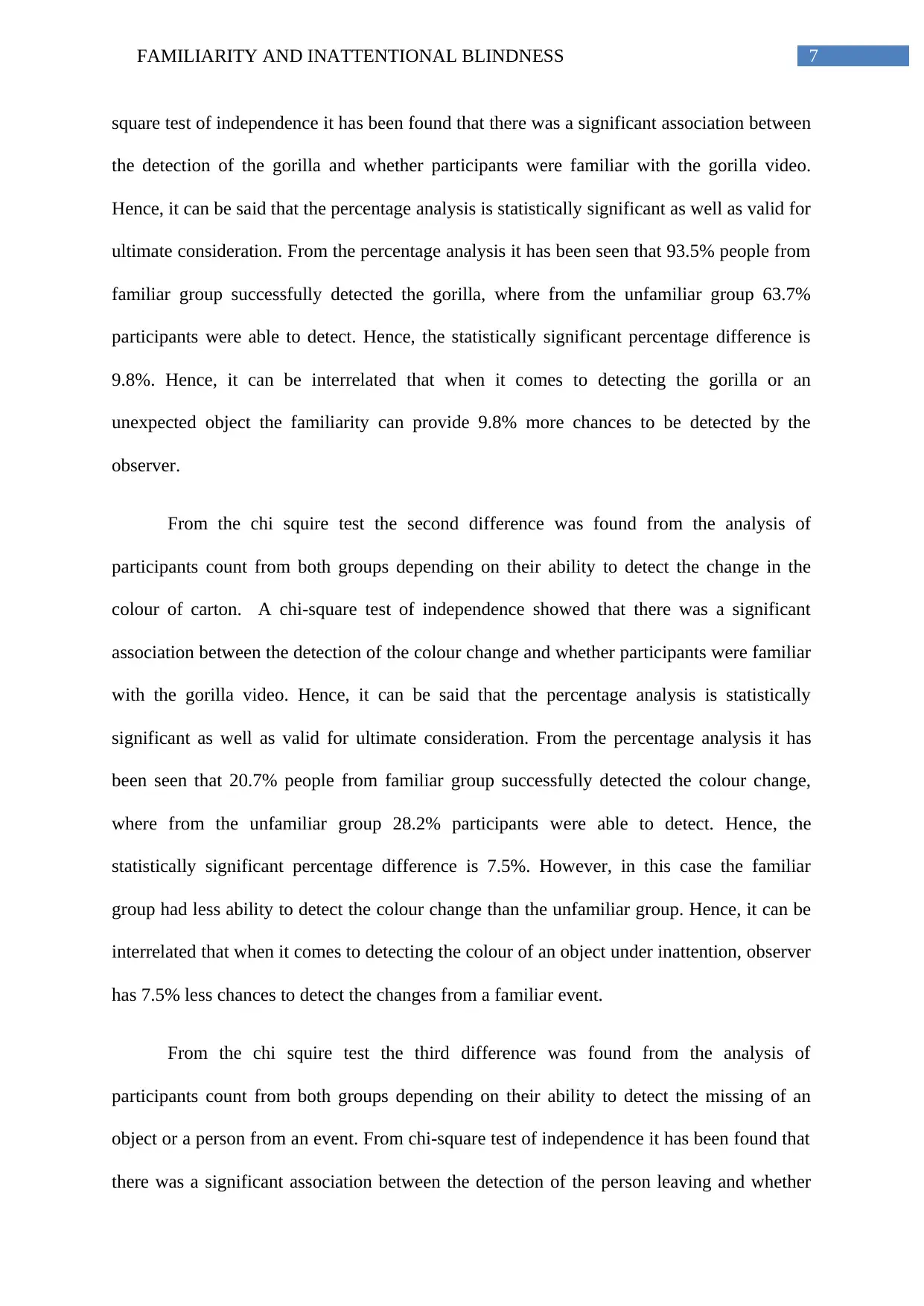
7FAMILIARITY AND INATTENTIONAL BLINDNESS
square test of independence it has been found that there was a significant association between
the detection of the gorilla and whether participants were familiar with the gorilla video.
Hence, it can be said that the percentage analysis is statistically significant as well as valid for
ultimate consideration. From the percentage analysis it has been seen that 93.5% people from
familiar group successfully detected the gorilla, where from the unfamiliar group 63.7%
participants were able to detect. Hence, the statistically significant percentage difference is
9.8%. Hence, it can be interrelated that when it comes to detecting the gorilla or an
unexpected object the familiarity can provide 9.8% more chances to be detected by the
observer.
From the chi squire test the second difference was found from the analysis of
participants count from both groups depending on their ability to detect the change in the
colour of carton. A chi-square test of independence showed that there was a significant
association between the detection of the colour change and whether participants were familiar
with the gorilla video. Hence, it can be said that the percentage analysis is statistically
significant as well as valid for ultimate consideration. From the percentage analysis it has
been seen that 20.7% people from familiar group successfully detected the colour change,
where from the unfamiliar group 28.2% participants were able to detect. Hence, the
statistically significant percentage difference is 7.5%. However, in this case the familiar
group had less ability to detect the colour change than the unfamiliar group. Hence, it can be
interrelated that when it comes to detecting the colour of an object under inattention, observer
has 7.5% less chances to detect the changes from a familiar event.
From the chi squire test the third difference was found from the analysis of
participants count from both groups depending on their ability to detect the missing of an
object or a person from an event. From chi-square test of independence it has been found that
there was a significant association between the detection of the person leaving and whether
square test of independence it has been found that there was a significant association between
the detection of the gorilla and whether participants were familiar with the gorilla video.
Hence, it can be said that the percentage analysis is statistically significant as well as valid for
ultimate consideration. From the percentage analysis it has been seen that 93.5% people from
familiar group successfully detected the gorilla, where from the unfamiliar group 63.7%
participants were able to detect. Hence, the statistically significant percentage difference is
9.8%. Hence, it can be interrelated that when it comes to detecting the gorilla or an
unexpected object the familiarity can provide 9.8% more chances to be detected by the
observer.
From the chi squire test the second difference was found from the analysis of
participants count from both groups depending on their ability to detect the change in the
colour of carton. A chi-square test of independence showed that there was a significant
association between the detection of the colour change and whether participants were familiar
with the gorilla video. Hence, it can be said that the percentage analysis is statistically
significant as well as valid for ultimate consideration. From the percentage analysis it has
been seen that 20.7% people from familiar group successfully detected the colour change,
where from the unfamiliar group 28.2% participants were able to detect. Hence, the
statistically significant percentage difference is 7.5%. However, in this case the familiar
group had less ability to detect the colour change than the unfamiliar group. Hence, it can be
interrelated that when it comes to detecting the colour of an object under inattention, observer
has 7.5% less chances to detect the changes from a familiar event.
From the chi squire test the third difference was found from the analysis of
participants count from both groups depending on their ability to detect the missing of an
object or a person from an event. From chi-square test of independence it has been found that
there was a significant association between the detection of the person leaving and whether
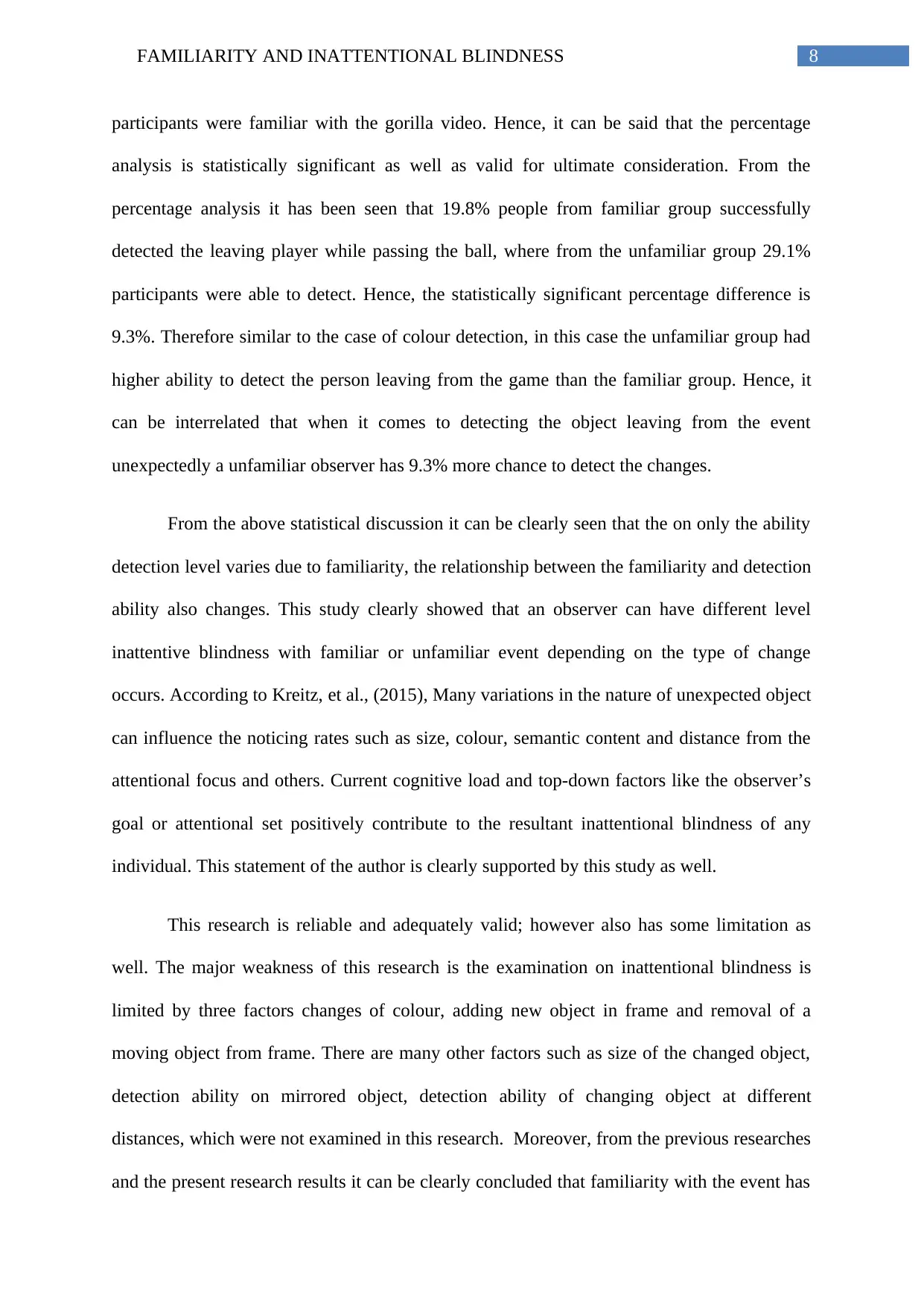
8FAMILIARITY AND INATTENTIONAL BLINDNESS
participants were familiar with the gorilla video. Hence, it can be said that the percentage
analysis is statistically significant as well as valid for ultimate consideration. From the
percentage analysis it has been seen that 19.8% people from familiar group successfully
detected the leaving player while passing the ball, where from the unfamiliar group 29.1%
participants were able to detect. Hence, the statistically significant percentage difference is
9.3%. Therefore similar to the case of colour detection, in this case the unfamiliar group had
higher ability to detect the person leaving from the game than the familiar group. Hence, it
can be interrelated that when it comes to detecting the object leaving from the event
unexpectedly a unfamiliar observer has 9.3% more chance to detect the changes.
From the above statistical discussion it can be clearly seen that the on only the ability
detection level varies due to familiarity, the relationship between the familiarity and detection
ability also changes. This study clearly showed that an observer can have different level
inattentive blindness with familiar or unfamiliar event depending on the type of change
occurs. According to Kreitz, et al., (2015), Many variations in the nature of unexpected object
can influence the noticing rates such as size, colour, semantic content and distance from the
attentional focus and others. Current cognitive load and top-down factors like the observer’s
goal or attentional set positively contribute to the resultant inattentional blindness of any
individual. This statement of the author is clearly supported by this study as well.
This research is reliable and adequately valid; however also has some limitation as
well. The major weakness of this research is the examination on inattentional blindness is
limited by three factors changes of colour, adding new object in frame and removal of a
moving object from frame. There are many other factors such as size of the changed object,
detection ability on mirrored object, detection ability of changing object at different
distances, which were not examined in this research. Moreover, from the previous researches
and the present research results it can be clearly concluded that familiarity with the event has
participants were familiar with the gorilla video. Hence, it can be said that the percentage
analysis is statistically significant as well as valid for ultimate consideration. From the
percentage analysis it has been seen that 19.8% people from familiar group successfully
detected the leaving player while passing the ball, where from the unfamiliar group 29.1%
participants were able to detect. Hence, the statistically significant percentage difference is
9.3%. Therefore similar to the case of colour detection, in this case the unfamiliar group had
higher ability to detect the person leaving from the game than the familiar group. Hence, it
can be interrelated that when it comes to detecting the object leaving from the event
unexpectedly a unfamiliar observer has 9.3% more chance to detect the changes.
From the above statistical discussion it can be clearly seen that the on only the ability
detection level varies due to familiarity, the relationship between the familiarity and detection
ability also changes. This study clearly showed that an observer can have different level
inattentive blindness with familiar or unfamiliar event depending on the type of change
occurs. According to Kreitz, et al., (2015), Many variations in the nature of unexpected object
can influence the noticing rates such as size, colour, semantic content and distance from the
attentional focus and others. Current cognitive load and top-down factors like the observer’s
goal or attentional set positively contribute to the resultant inattentional blindness of any
individual. This statement of the author is clearly supported by this study as well.
This research is reliable and adequately valid; however also has some limitation as
well. The major weakness of this research is the examination on inattentional blindness is
limited by three factors changes of colour, adding new object in frame and removal of a
moving object from frame. There are many other factors such as size of the changed object,
detection ability on mirrored object, detection ability of changing object at different
distances, which were not examined in this research. Moreover, from the previous researches
and the present research results it can be clearly concluded that familiarity with the event has

9FAMILIARITY AND INATTENTIONAL BLINDNESS
both direct and reciprocal relationship with the inattentional blindness, where adding a new
object of the observational frame has more potential to be detected in familiar observer,
however changes in colour and eliminating any object from frame has more potential to be
detected for unfamiliar observer.
both direct and reciprocal relationship with the inattentional blindness, where adding a new
object of the observational frame has more potential to be detected in familiar observer,
however changes in colour and eliminating any object from frame has more potential to be
detected for unfamiliar observer.
Secure Best Marks with AI Grader
Need help grading? Try our AI Grader for instant feedback on your assignments.
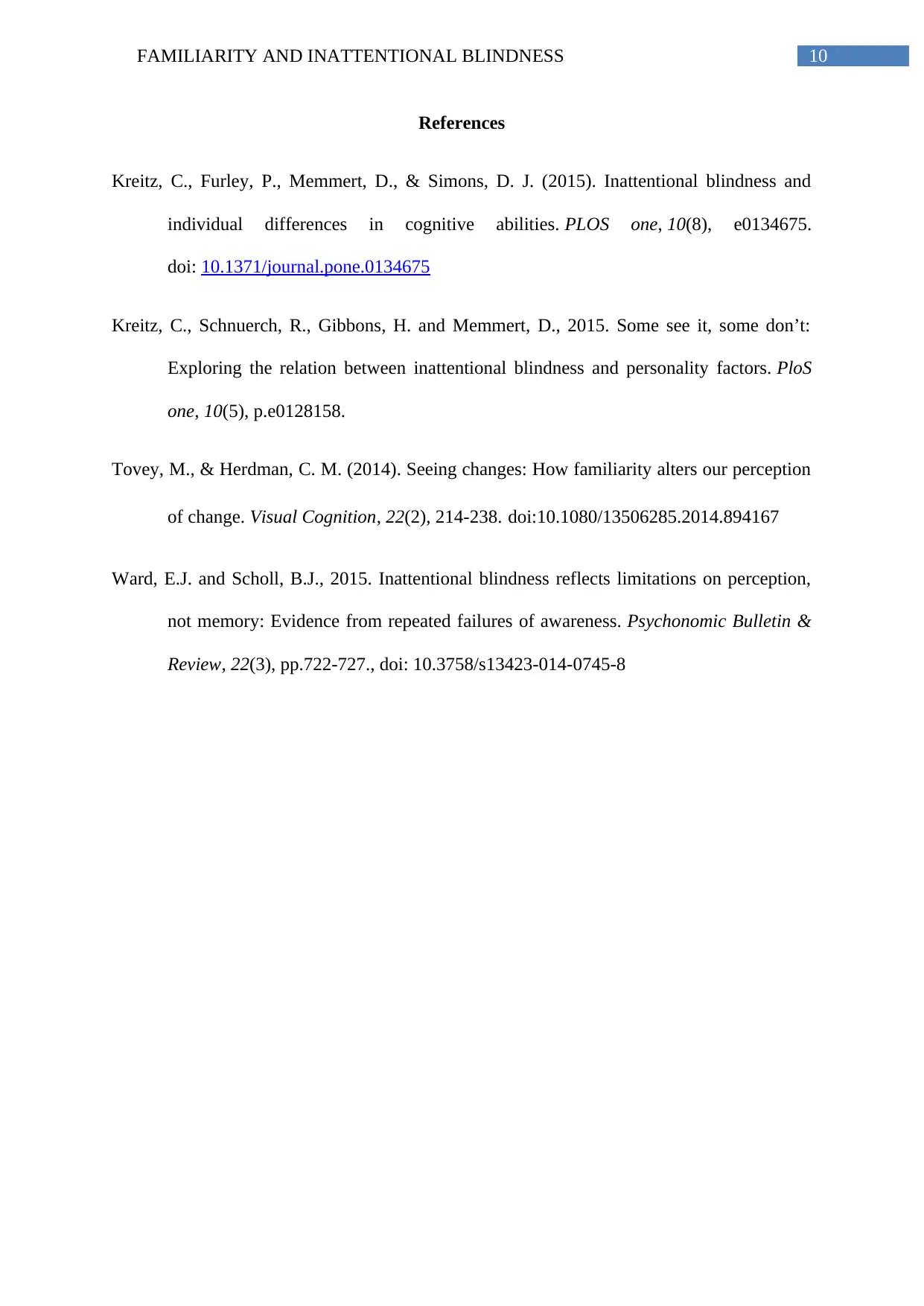
10FAMILIARITY AND INATTENTIONAL BLINDNESS
References
Kreitz, C., Furley, P., Memmert, D., & Simons, D. J. (2015). Inattentional blindness and
individual differences in cognitive abilities. PLOS one, 10(8), e0134675.
doi: 10.1371/journal.pone.0134675
Kreitz, C., Schnuerch, R., Gibbons, H. and Memmert, D., 2015. Some see it, some don’t:
Exploring the relation between inattentional blindness and personality factors. PloS
one, 10(5), p.e0128158.
Tovey, M., & Herdman, C. M. (2014). Seeing changes: How familiarity alters our perception
of change. Visual Cognition, 22(2), 214-238. doi:10.1080/13506285.2014.894167
Ward, E.J. and Scholl, B.J., 2015. Inattentional blindness reflects limitations on perception,
not memory: Evidence from repeated failures of awareness. Psychonomic Bulletin &
Review, 22(3), pp.722-727., doi: 10.3758/s13423-014-0745-8
References
Kreitz, C., Furley, P., Memmert, D., & Simons, D. J. (2015). Inattentional blindness and
individual differences in cognitive abilities. PLOS one, 10(8), e0134675.
doi: 10.1371/journal.pone.0134675
Kreitz, C., Schnuerch, R., Gibbons, H. and Memmert, D., 2015. Some see it, some don’t:
Exploring the relation between inattentional blindness and personality factors. PloS
one, 10(5), p.e0128158.
Tovey, M., & Herdman, C. M. (2014). Seeing changes: How familiarity alters our perception
of change. Visual Cognition, 22(2), 214-238. doi:10.1080/13506285.2014.894167
Ward, E.J. and Scholl, B.J., 2015. Inattentional blindness reflects limitations on perception,
not memory: Evidence from repeated failures of awareness. Psychonomic Bulletin &
Review, 22(3), pp.722-727., doi: 10.3758/s13423-014-0745-8
1 out of 11
Your All-in-One AI-Powered Toolkit for Academic Success.
+13062052269
info@desklib.com
Available 24*7 on WhatsApp / Email
![[object Object]](/_next/static/media/star-bottom.7253800d.svg)
Unlock your academic potential
© 2024 | Zucol Services PVT LTD | All rights reserved.

